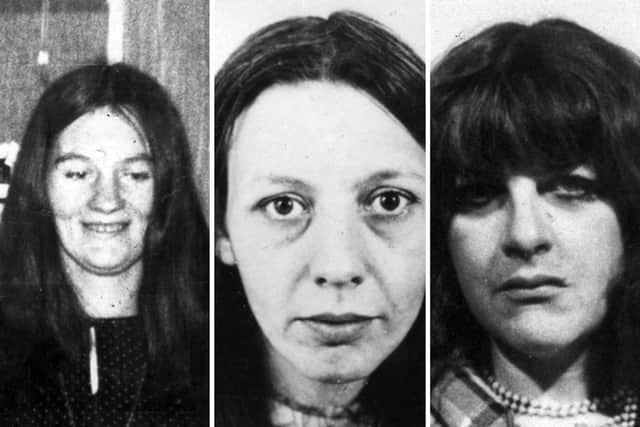Peter Sutcliffe has died but our thoughts are with the 13 innocent women he murdered - The Yorkshire Post says
Our thoughts – and those of the whole country – are today with these 13 innocent women, and all who knew them or were touched by their tragically short lives, rather than their serial killer Peter Sutcliffe whose death ends one of the most sickening and notorious chapters in Yorkshire history.
The so-called ‘Yorkshire Ripper’ was the monster from hell who murdered these women, attempted to murder seven others – and scarred an entire generation who were left living in fear of this evil sexual predator throughout the 1970s.
Advertisement
Hide AdAdvertisement
Hide AdEven now, four decades after his capture and conviction, mere mention of the name Sutcliffe, or any reference to the ‘Ripper’, still haunts all those women left terrified and traumatised by his gruesome and depraved reign of terror as he pounced on the vulnerable and unsuspecting.


As such, no tears deserve to be shed for the one-time gravedigger and lorry driver born in Bingley and who settled in nearby Bradford whose death, at the age of 74, has been confirmed by the Prison Service. He had been reportedly suffering from cancer and, more recently, Covid.
They should be saved for the relatives, acquaintances and friends of the 13 women who he is known to have killed between 1975 and 1980 – their life sentence and grief goes on – and those families living in torment because they don’t know whether their loved ones were also victims of the mass murderer.
Chillingly, the scale of these crimes may never be known. As the Inspector of Constabulary Sir Lawrence Byford’s official report said: “We feel it is highly improbable that the crimes in respect of which Sutcliffe has been charged and convicted are the only ones attributable to him.”
Advertisement
Hide AdAdvertisement
Hide AdSutcliffe’s lack of remorse, from the moment of his arrest to his eventual death, means there’s little, if any, likelihood of these families receiving the closure, or justice, they desire in spite of clear links between their cases - and those that formed part of his successful prosecution at the Old Bailey in 1981.
Instead he simply spent nearly four decades exploiting his infamy, and seeking special treatment from the criminal justice system, because of the threats posed to him by other inmates in high security prisons and the Broadmoor psychiatric hospital.
Abuses of status that must never be allowed to happen again, they were also the actions of a coward undeserving of the fascination, and added attention that he will inevitably receive in death, by everyone from criminologists and psychologists to the more depraved, ghoulish and warped.
Frankly, his human rights should have ended on the day of his conviction, as distinct from his arrest that came about purely by chance in Sheffield as he preyed upon a vulnerable prostitute in the city’s red light district when a routine check by two police officers, including a probationer, revealed Sutcliffe’s car had false number plates.
Advertisement
Hide AdAdvertisement
Hide AdWhen they returned to the scene of the arrest, they discovered a knife, hammer and rope that Britain’s most wanted man had discarded.
This extraordinary piece of luck on the evening of January 2, 1981, brought an end to the biggest manhunt in Yorkshire history – one that ultimately embarrassed West Yorkshire Police who were so overwhelmed that a number of chances to identify, and arrest, Sutcliffe were missed.
Left floundering, their incident room at Millgarth Police Station in Leeds was in a state of total chaos and unable to adequately cross-check the details of 157,000 cars, 130,000 separate actions, 28,600 statements, 27,000 house to house inquiries – all while placing virtual blind faith into indulging the hoaxer John Humble who came to be known as ‘Wearside Jack’ and who was convicted in 2006 of four counts of perverting the course of justice.
This distraction proved to be a humiliating one for Assistant Chief Constable George Oldfield who was heading the manhunt and was duped by the callous hoax.
Advertisement
Hide AdAdvertisement
Hide AdA detective entrusted with the investigation into the M62 coach bombing by the IRA, his reputation never recovered. Even Margaret Thatcher had to be persuaded not to visit Yorkshire, and take personal charge of the inquiry, because the Prime Minister then believed that the Ripper’s evasion would reflect badly on her already deeply unpopular government.
However the only consolation - and it is a reassuring one - is that the case led to a fundamental overhaul of policing that makes it much harder for criminals to slip through the net as Sutcliffe did on repeated occasions.
The advent of DNA technology is another weapon now at the police’s disposal while their wider approach towards all sexual offences is far more enlightened now in comparison to the 1970s and the more recent CSE grooming cases that have also scarred this region’s reputation.
But such progress is almost academic on a day which, above all else, is about the victims of Peter Sutcliffe as their murderer and tormenter finally rots in the hell to which he belongs.
------------------------
Advertisement
Hide AdAdvertisement
Hide AdSupport The Yorkshire Post and become a subscriber today. Your subscription will help us to continue to bring quality news to the people of Yorkshire. In return, you'll see fewer ads on site, get free access to our app and receive exclusive members-only offers. Click here to subscribe.